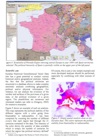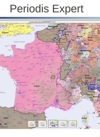Where is My Country?
IV - Where is My Country?
Euratlas Periodis does not present pleasant maps giving an idealized view of every country. Thus, it happens that some states, at some centuries, appear smaller than expected or with less power than wanted. Many persons are annoyed when Periodis does not display exactly what they would like to see but we always pay attention to errors or omissions in the layout of the borders if reported with references. Moreover, we have to keep in mind that, in most cases, the maps describe a political situation dating back to 4, 5, 10 centuries or even more.
1) In 1600 the king of Portugal was dead, but Portugal never was part of Spain, they just controlled our country for our kingdom security. So, why do you show Portugal as part of Spain?
From 1580 until 1640, for various political reasons, Portugal was united to Spain under the same king, Formally, Portugal did not lose its independence but had no separate foreign policy. Moreover, in 1600, the Spanish Monarchy was organized in several entities, among which there was even one semi-independent country: the Spanish Netherlands. Thus, we have shown the kingdom of Portugal as a first level division of the Spanish Monarchy, like Castile, Aragon, Sardinia, Naples or Milan. Moreover, it appears that even Portuguese historical atlases have chosen this kind of presentation. See, for instance, Marques de Oliveira 'Atlas historico de Portugal e do Ultramar Português', Centro de Estudos Historicos 2003, p. 267.
2) Why there is no Carantania for the period 670 to 1441?
Carantania or Korotan was a small Slavic entity covering, more or less, the upper Drava and Mur basins. However the sources are scarce and the extent of this principality is hypothetical. Nevertheless, we have drawn its approximate area on the maps 600 and 700. After 745 Carantania was integrated in the Frankish Empire under the Germanized name of Kärnten or Carinthia and passed to the Habsburgs in 1335.
3) Poland and Lithuania were the same country in 1700, but how did you get Saxony in its name?
In 1697, 18 candidates coveted the Crown of Poland, which ultimately went to Frederick Augustus Elector of Saxony who, from Lutheranism, converted to Roman Catholicism to ensure his election. Thus the Polish-Lithuanian Commonwealth was ruled, in personal union, by the Elector of Saxony who tried, but failed, to unite both states.
4) Why the country of Illyricum doesn't make even a brief appearance in the history of Europe?
It seems that, since the 8th century BC, several small kingdoms existed in or around the Dinaric Alps and many historians call them the Illyrian kingdoms but the sources are scarce and the earliest references are based more on mythology than on historical records. Various tribes sharing presumably a common language and culture were living in the area comprised between the Adriatic Sea and the Danube but that does not attest the existence of a large political entity called Illyria or Illyricum. Anyway, this area was conquered by the Roman state between the 2nd century BC and the 1st century AD. We only know that a large tribe or tribe federation, the Scordisci, presumably of Celtic origin, was occupying the region between Sava and Drava before the Roman conquest.
5) Why do you omit the Serbian despotate in 1400 and represent it prematurely as part of the Ottoman empire?
After the Battle of Kosovo in 1389, the Serbian despotate, under the rule of Stefan Lazarevic, became a state vassal to the Ottoman Empire and the Serbian troops were obliged to fight on the Ottoman side, for instance at the Battle of Angora or Ankara in 1402. This is explained in George Ostrogorsky 'History of the Byzantine State'. In the Periodis maps, you will notice that, for 1400, the Despotate of Serbia is shown as a semi-independent entity under the overlordship of the Ottomans, thus framed by a dotted line of the same color as the Ottoman Empire.
6) I am interested to see the history of my country. It is an European country. What happened to Andorra?
Since 1278, the land of Andorra is a pareage, a kind of co-sovereignty, between the count of Foix et the Bishop of Urgell. Today the sovereignty over this small country is still shared between the bishop of Urgell and the President of the French Republic, as successor of the count of Foix. Sadly enough, your country is too small to appear clearly on the Periodis atlas and the same is true for Liechtenstein, Monaco and several tiny states.
7) Where is Byzantium on the historical map?
The name 'Byzantine Empire' was coined by the German scholar Hieronymus Wolf, author of the 'Corpus Historiae Byzantinae', in 1557, that is 104 years after the fall of this state. Actually, H. Wolf draw his inspiration from the 'Donation of Constantine', a fake Roman imperial decree forged in the 8th century by the Papal chancellery in order to support the Pope in his negotiations with the Frankish kingdom. In this text, one can read "...et in Byzantias provincias.." (= and in the province of [the city of] Byzantium). The forgery was proved in 1440 by the Italian humanist Lorenzo Valla but the Papacy held the document as undisputed until the 19th century when the German theologian Ignaz von Döllinger recognized the hoax. Meanwhile, the wording Byzantine Empire had become usual in historiography.
8) Why to you treat the Byzantine Empire as an unknown land and replace it by a dirty Roman Empire?
After the 3rd century military anarchy, in AD 293, the government of the Roman Empire was reorganized and the power was split into several rulers, some of which supposedly held the supreme authority. This division of the government was not permanent and some subsequent emperors, Constantine the Great, Julian the Apostate and Theodosius I, managed to rule over the whole empire during the 4th century. Nevertheless, for various reasons, among which the Barbarian Invasions, we can assume that since about 438, the legal unity of the Empire had vanished and in 476, its western half had disappeared. In AD 500, only one emperor remained at Constantinople, or Byzantium, ruling over the eastern half of the Empire. However, the emperors residing at Constantinople continued to style themselves 'Imperator Romanorum' and to consider the Roman Empire as a whole until, to say the less, 1204 AD, official date of the partition of the lands of the Roman Empire (Partitio Terrarum Imperii Romaniae). During, these seven centuries, the official Latin name of the state was Roman Empire, Res Publica Romana, Πολιτεία τῶν Ῥωμαίων (Politeίa tôn Rhōmaíōn), Romania, Ῥωμανία, (Rhōmanía), Βασιλεία τῶν Ῥωμαίων, (Basileia tôn Rhōmaiōn), Αρχη τῶν Ῥωμαίων (Arche tôn Rhōmaíōn). This is attested by a wide range of medieval sources like Theophylact Simocatta, Theophanes the Confessor, Constantine VII Porphyrogenitus, John Skylitzes, Anna Komnene, Geoffrey of Villehardouin and many other authors.
See also the article
From Historical Mapping To Historical Geographical
Information System

PDF format
or the presentation

PDF format
Periodical Historical Atlas of Europe
according to your needs